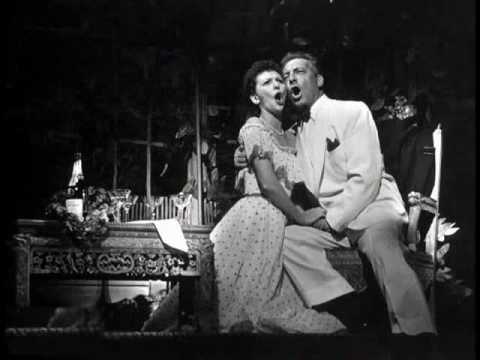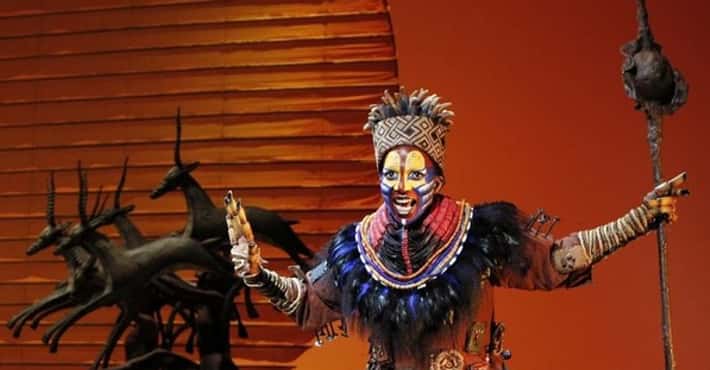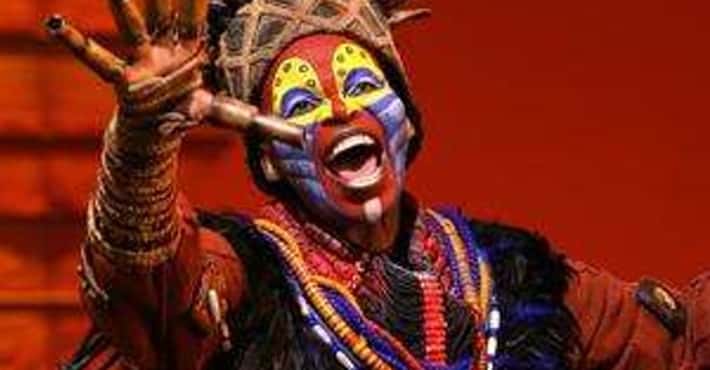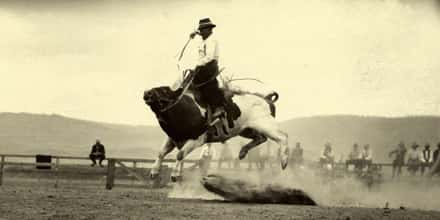The Best Musicals by Rodgers and Hammerstein
Ranked By
1.2K votes
333 voters
1 reranks
Voting Rules
Vote up the best Rodgers and Hammerstein musicals.
- The Sound of Music is a multiple Tony Award-winning musical by Richard Rodgers, lyrics by Oscar Hammerstein II and a book by Howard Lindsay and Russel Crouse. It is based on the memoir of Maria von Trapp, The Story of the Trapp Family Singers. Many songs from the musical have become standards, such as "Edelweiss", "My Favorite Things", "Climb Ev'ry Mountain", "Do-Re-Mi", and the title song "The Sound of Music". The original Broadway production, starring Mary Martin and Theodore Bikel, opened on November 16, 1959. This production was a five time winner at the 14th Tony Awards, out of nine nominations. The original London production opened at The Palace Theatre on May 18, 1961 starring Jean Bayless and Roger Dann. The show has enjoyed numerous productions and revivals since then, with a 1998 Broadway production earning a Tony nomination for Best Revival. It was adapted as a 1965 film musical starring Julie Andrews and Christopher Plummer, which won five Academy Awards. The Sound of Music was the final musical written by Rodgers and Hammerstein; Oscar Hammerstein died of cancer nine months after the Broadway premiere.More The Sound of Music
- #6 of 186 onThe Greatest Musicals Ever Performed On Broadway, Ranked
- #6 of 74 onThe Best Tony Award Winning Musicals
- #8 of 39 onThe Best Broadway Shows for Kids
- Oklahoma! is the first musical written by the team of composer Richard Rodgers and librettist Oscar Hammerstein II. The musical is based on Lynn Riggs' 1931 play, Green Grow the Lilacs. Set in farm country outside the town of Claremore, Indian Territory, in 1906, it tells the story of farm girl Laurey Williams and her courtship by two rival suitors, cowboy Curly McLain and the sinister and frightening farmhand Jud Fry. A secondary romance concerns cowboy Will Parker and his flirtatious fiancée, Ado Annie. The original Broadway production opened on March 31, 1943. It was a box-office smash and ran for an unprecedented 2,212 performances, later enjoying award-winning revivals, national tours, foreign productions and an Academy Award-winning 1955 film adaptation. It has long been a popular choice for school and community productions. Rodgers and Hammerstein won a special Pulitzer Prize for Oklahoma! in 1944. This musical, building on the innovations of the earlier Show Boat, epitomized the development of the "book musical", a musical play where the songs and dances are fully integrated into a well-made story with serious dramatic goals that are able to evoke genuine emotions other than laughter. In addition, Oklahoma! features musical themes, or motifs, that recur throughout the work to connect the music and story. A fifteen-minute "dream ballet" reflects Laurey's struggle with her feelings about two men, Curly and Jud.
- The King and I is the fifth musical by the team of composer Richard Rodgers and dramatist Oscar Hammerstein II. It is based on Margaret Landon's novel, Anna and the King of Siam (1944), which is in turn derived from the memoirs of Anna Leonowens, governess to the children of King Mongkut of Siam in the early 1860s. The musical's plot relates the experiences of Anna, a British schoolteacher hired as part of the King's drive to modernize his country. The relationship between the King and Anna is marked by conflict through much of the piece, as well as by a love to which neither can admit. The musical premiered on March 29, 1951, at Broadway's St. James Theatre. It ran for nearly three years, making it the fourth longest-running Broadway musical in history at the time, and has had many tours and revivals. In 1950, theatrical attorney Fanny Holtzmann was looking for a part for her client, veteran leading lady Gertrude Lawrence. Holtzmann realized that Landon's book would provide an ideal vehicle and contacted Rodgers and Hammerstein, who were initially reluctant but agreed to write the musical. The pair initially sought Rex Harrison to play the supporting part of the King, a role he had played in the 1946 film made from Landon's book, but he was unavailable. They settled on the young actor and television director Yul Brynner. The musical was an immediate hit, winning Tony Awards for Best Musical, Best Actress (for Lawrence) and Best Featured Actor (for Brynner). Lawrence died unexpectedly of cancer a year and a half after the opening, and the role of Anna was played by several actresses during the remainder of the Broadway run of 1,246 performances. A hit London run and U.S. national tour followed, together with a 1956 film for which Brynner won an Academy Award, and the musical was recorded several times. In later revivals, Brynner came to dominate his role and the musical, starring in a four-year national tour culminating in a 1985 Broadway run shortly before his death. Christopher Renshaw directed major revivals on Broadway (1996), winning the Tony Award for Best Revival, and in the West End (2000). A 2015 Broadway revival won another Tony for Best Revival. Both professional and amateur revivals of The King and I continue to be staged regularly throughout the English-speaking world.More The King and I
- Dig Deeper...Every Song in The King and I, Ranked by Singability
- #44 of 186 onThe Greatest Musicals Ever Performed On Broadway, Ranked
- #14 of 74 onThe Best Tony Award Winning Musicals
- South Pacific is a musical composed by Richard Rodgers, with lyrics by Oscar Hammerstein II and book by Hammerstein and Joshua Logan. The work premiered in 1949 on Broadway and was an immediate hit, running for 1,925 performances. The story is based on James A. Michener's Pulitzer Prize-winning 1947 book Tales of the South Pacific, combining elements of several of the stories. Rodgers and Hammerstein believed that they could write a musical based on Michener's work that would be financially successful and, at the same time, would send a strong progressive message on racism. The plot centers on an American nurse stationed on a South Pacific island during World War II who falls in love with a middle-aged expatriate French plantation owner but struggles to accept his mixed-race children. A secondary romance, between a U.S. lieutenant and a young Tonkinese woman, explores his fears of the social consequences should he marry his Asian sweetheart. The issue of racial prejudice is candidly explored throughout the musical, most controversially in the lieutenant's song, "You've Got to Be Carefully Taught".
- Carousel is the second musical by the team of Richard Rodgers (music) and Oscar Hammerstein II (book and lyrics). The 1945 work was adapted from Ferenc Molnár's 1909 play Liliom, transplanting its Budapest setting to the Maine coastline. The story revolves around carousel barker Billy Bigelow, whose romance with millworker Julie Jordan comes at the price of both their jobs. He participates in a robbery to provide for Julie and their unborn child; after it goes tragically wrong, he is given a chance to make things right. A secondary plot line deals with millworker Carrie Pipperidge and her romance with ambitious fisherman Enoch Snow. The show includes the well-known songs "If I Loved You", "June Is Bustin' Out All Over" and "You'll Never Walk Alone". Richard Rodgers later wrote that Carousel was his favorite of all his musicals. Following the spectacular success of the first Rodgers and Hammerstein musical, Oklahoma! (1943), the pair sought to collaborate on another piece, knowing that any resulting work would be compared with Oklahoma!, most likely unfavorably. They were initially reluctant to seek the rights to Liliom; Molnár had refused permission for the work to be adapted in the past, and the original ending was considered too depressing for the musical theatre. After acquiring the rights, the team created a work with lengthy sequences of music and made the ending more hopeful. The musical required considerable modification during out-of-town tryouts, but once it opened on Broadway on April 19, 1945, it was an immediate hit with both critics and audiences. Carousel initially ran for 890 performances and duplicated its success in the West End in 1950. Though it has never achieved as much commercial success as Oklahoma!, the piece has been repeatedly revived, recorded several times and was filmed in 1956. A production by Nicholas Hytner enjoyed success in 1992 in London, in 1994 in New York and on tour. Another Broadway revival opened in 2018. In 1999, Time magazine named Carousel the best musical of the 20th century.
 6
6Cinderella
- Flower Drum Song was the eighth musical by the team of Richard Rodgers and Oscar Hammerstein II. It was based on the 1957 novel, The Flower Drum Song, by Chinese-American author C. Y. Lee. The piece opened in 1958 on Broadway and was afterwards presented in the West End and on tour. It was subsequently made into a 1961 musical film. After their extraordinary early successes, beginning with Oklahoma! in 1943, Rodgers and Hammerstein had written two musicals in the 1950s that did not do well and sought a new hit to revive their fortunes. Lee's novel focuses on a father, Wang Chi-yang, a wealthy refugee from China, who clings to traditional values in San Francisco's Chinatown. Rodgers and Hammerstein shifted the focus of the musical to his son, Wang Ta, who is torn between his Chinese roots and assimilation into American culture. The team hired Gene Kelly to make his debut as a stage director with the musical and scoured the country for a suitable Asian – or at least, plausibly Asian-looking – cast. The musical, much more light-hearted than Lee's novel, was profitable on Broadway and was followed by a national tour.
 8
8State Fair
State Fair is a musical with a book by Tom Briggs and Louis Mattioli, lyrics by Oscar Hammerstein II, and music by Richard Rodgers. Phil Stong's original novel, State Fair, was first adapted for film in 1933 in a production starring Will Rogers. In 1945, the film was remade as a musical with original songs by Rodgers and Hammerstein. This was subsequently remade in 1962 as well as adapted into a made-for-television movie in 1976. The stage production closely follows the plot of its predecessors, providing a glimpse into the life of a farming family, the Frakes, and their three-day adventure at the Iowa State Fair in Des Moines in 1946. While parents Abel and Melissa are hoping to win a few blue ribbons, siblings Margy and Wayne are more interested in finding romance on the midway.- Allegro is a musical by Richard Rodgers and Oscar Hammerstein II, their third collaboration for the stage. Opening on Broadway on October 10, 1947, the musical centers on the life of Joseph Taylor, Jr., who follows in the footsteps of his father as a doctor, but is tempted by fortune and fame at a big-city hospital. After the immense successes of the first two Rodgers and Hammerstein musicals, Oklahoma! and Carousel, the pair sought a subject for their next play. Hammerstein had long contemplated a serious work which would deal with the problems of the ordinary man in the fast-moving modern world. He and Rodgers sought to create a work which would be as innovative as their first two stage musicals. To that end, they created a play with a large cast, including a Greek chorus. The production would have no sets; props and projections served to suggest locations. After a disastrous tryout in New Haven, Connecticut, the musical opened on Broadway to a large advance sale of tickets, and very mixed reviews. Agnes de Mille, the choreographer of Rodgers and Hammerstein's previous Broadway productions, both directed and choreographed the work.
 10
10A Grand Night for Singing
A Grand Night for Singing is a musical revue showcasing the music of Richard Rodgers and the lyrics of Oscar Hammerstein II. Featuring songs from such lesser-known works as Allegro, Me and Juliet, State Fair, and Pipe Dream, modest successes like Flower Drum Song and hits like Carousel, Oklahoma!, The King and I, South Pacific, Cinderella and The Sound of Music, it originally was presented cabaret-style at Rainbow & Stars at the top of Rockefeller Center. After 41 previews, the Broadway production, directed by Walter Bobbie and choreographed by Pamela Sousa, with vocal arrangements by Fred Wells and orchestrations by Michael Gibson and Jonathan Tunick, opened on November 17, 1993 at the Criterion Center Stage Right, where it ran for 52 performances. Victoria Clark, Jason Graae, Alyson Reed, Martin Vidnovic, and Lynne Wintersteller comprised the cast. Martin Vidnovic is replaced by Gregg Edelman in the cast recording, and some later performances. It was nominated for two Tony Awards, for Best Musical and Best Book of a Musical, and the Drama Desk Award for Outstanding Revue. An original cast recording was released by Varèse Sarabande. 11
11Pipe Dream
Pipe Dream is the seventh musical by the team of Richard Rodgers and Oscar Hammerstein II; it premiered on Broadway on November 30, 1955. The work is based on John Steinbeck's short novel Sweet Thursday—Steinbeck wrote the novel, a sequel to Cannery Row, in the hope of having it adapted into a musical. Set in Monterey, California, the musical tells the story of the romance between Doc, a marine biologist, and Suzy, who in the novel is a prostitute; her profession is only alluded to in the stage work. Pipe Dream was a relative failure- Me and Juliet is a musical comedy by Richard Rodgers and Oscar Hammerstein II and their sixth stage collaboration. The work tells a story of romance backstage at a long-running musical: assistant stage manager Larry woos chorus girl Jeanie behind the back of her electrician boyfriend, Bob. Me and Juliet premiered in 1953 and was not considered a success, although it ran for much of a year on Broadway and returned a small profit to its backers. The show received no Tony Award nominations. Rodgers had long wanted to write a musical comedy about the cast and crew backstage at a theatre. After Rodgers and Hammerstein had another hit with The King and I, Rodgers proposed the backstage project to his partner. Hammerstein was unenthusiastic, thinking the subject matter trivial, but agreed to do the project. The play required complex machinery, designed by Jo Mielziner, so that the audience could view action not only on the stage of the theatre where the show-within-the-show takes place, but in the wings and on the light bridge as well. When Me and Juliet began tryout performances in Cleveland, the duo realized that the show had problems with the plot and staging.















































